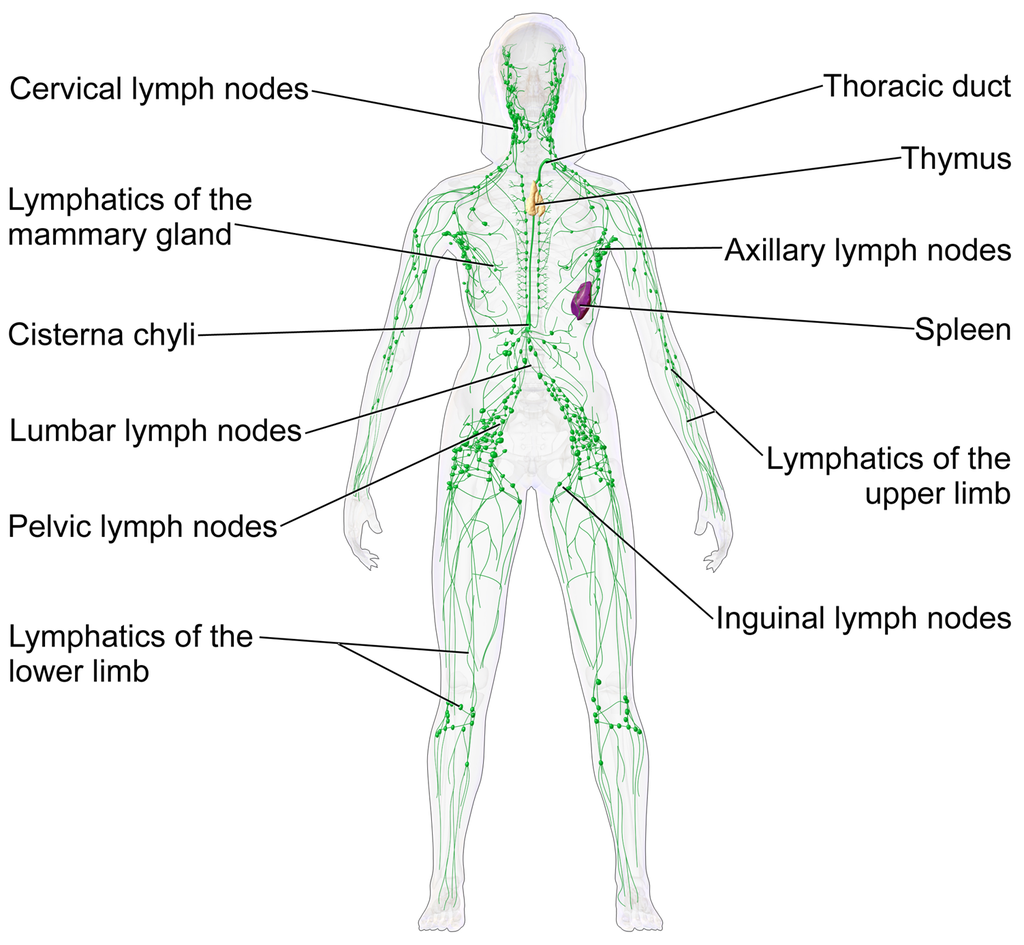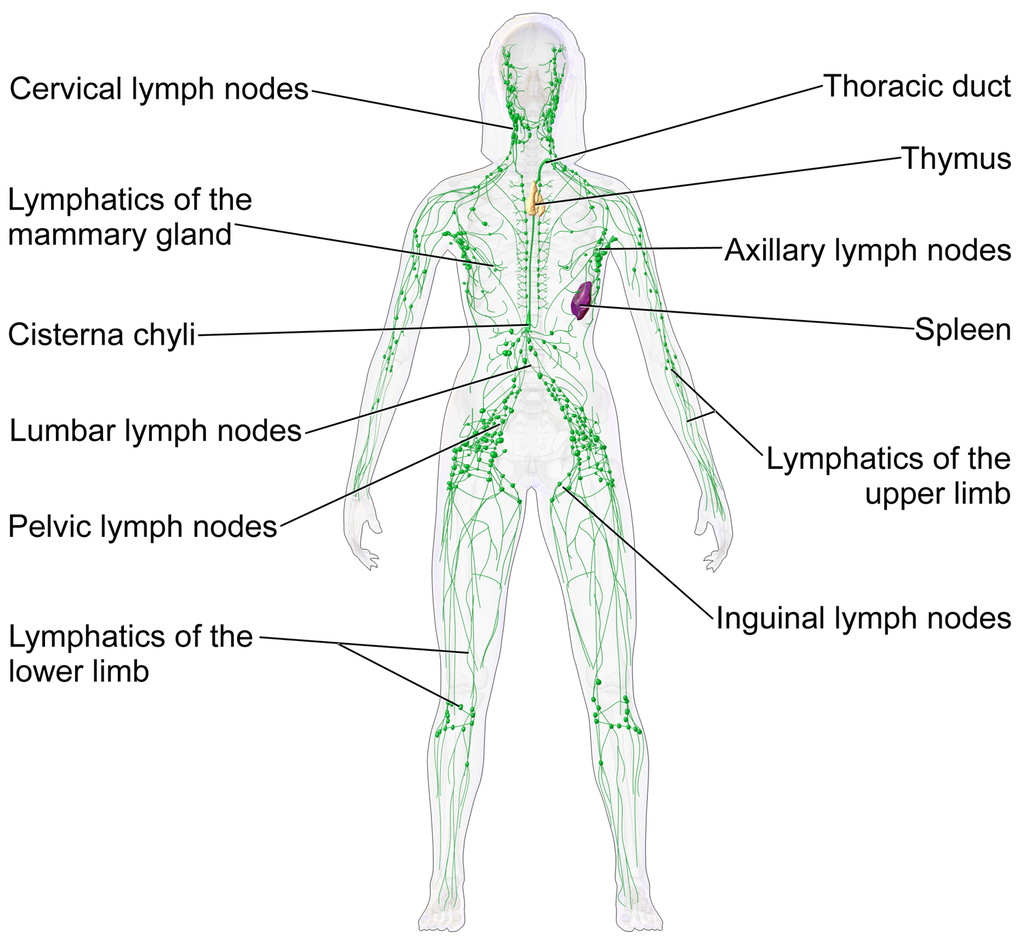The Lymphatic System
The lymphatic system is a network of tissues, organs, and vessels that help the body maintain its fluid balance. Arterial blood carries oxygen, nutrients and hormones to deliver to cells. Once these nutrients leave the arterial super highway, they flow through a liquidy substance between cells called interstitial fluid, to then bring nourishment to the cells. Ninety percent of the excess fluid returns to the circulatory system. The remaining 10% of the fluid, which is left out of the circulatory system, is called lymph, which carries with it waste products that were removed from the cells, as well as undigested proteins.
The lymphatic system identifies and fights infection thus protecting us from various pathogens. The lymphatic system consists of lymphangion pumps, a series of vessels, and a fluid called lymph, which contains white blood cells. Lymph however, doesn’t circulate around like blood. Instead, it is collected from the tissues and delivered to the blood. It relies on a change in tissue pressure and small drainage pumps. The lymphatic system is directly connected to the circulatory system and it assists the circulatory system in its job. It is vital for the functioning of the circulatory and immune systems.
The Lymphatic Pathway
Tissue fluid is transported all along the lymphatic pathway. The lymphatic pathway consists of lymph capillaries, lymph nodes, lymph ducts and lymphatic veins. Along this pathway, lymph nodes filter the lymph and valves prevent backflow of lymph. Lymph flows from lymphatic vessels into lymphatic trunks, and finally into the collecting ducts where the lymph is disposed into the subclavian veins.
Major Accessory Lymphatic Organs

1. Tonsils
The pharyngeal mucous membrane has masses of lymphoid tissue which are covered by epithelium, with deep pits/crypts that often contain food debris, bacteria, dead white blood cells (WBCs), etc. Pharyngeal tonsils (on the wall of pharynx behind nasal cavity), palatine tonsils (at the posterior margin of the oral cavity) and lingual tonsils (tongue) are the three main pairs of tonsils.
2. Spleen:
The spleen is the largest of the lymphatic organs located below diaphragm on the left side. It performs several functions as below:
- Helps screen blood and removes pathogens and bacteria
- Helps in production of monocytes and lymphocytes. Before birth, red blood cell (RBC) production also takes place here.
- The spleen is the “erythrocyte graveyard” as erythrocytes (RBCs) and platelets are destroyed here. The iron from RBC’s however, is salvaged.
- It acts as a reservoir of blood and can pump blood into circulatory system in case of hemorrhage.
3. Thymus
This unpaired organ in the mediastinum and neck region plays a vital role in initial set up of body’s immune system. It is the source of lymphocytes before birth, which circulates to the spleen, nodes and vessels. After birth, it secretes a hormone that causes lymphocytes to develop into plasma cells. Once this job is done it degenerates and is replaced by fat.
4. Lacteals
These are specialized lymphatic capillaries in the villi of the intestine used to absorb fats and oils after digestion
5. Peyer’s patches: These are oval elevated patches of closely packed lymph follicles on the mucosa of the small intestines
Functions of the Lymphatic System
1. Maintains fluid balance: The lymphatic system maintains the volume and pressure of extracellular fluid by returning excess water and dissolved substances from the interstitial fluid to the circulation system.
2. Returns large molecules to blood: 25-50% of blood proteins leak out of capillaries each day. Because they cannot get back into the capillaries, lymphatic capillaries pick them up and return them to the blood. If lymphatics are blocked, blood protein decreases leading to fluid imbalances in the body.
4. Hemopoiesis (Production of blood cells): Lymph nodes and other lymphoid tissues produce lymphocytes and macrophages (WBCs) in the specific immune response.
5. Body Defence/Immunity: Lymphocytes and macrophages are produced and stored by the lymphatic tissues and organs. They play a major role in building our immunity. A major role of the lymphatic system is to screen the body fluids and remove the pathogens and damaged cells.
6. Absorb and Transport Fats: Lymphatic capillaries called lacteals, absorb certain fatty acids in the small intestine.
Diseases of Lymphatic System
1. Lymphoedema: Excessive accumulation of interstitial fluid resulting from injury, inflammation, surgery, or parasitic infections is known as lymphoedema. It is caused by disruption of the lymphatic flow.
2. Metastatic Cancers: When cancer cells break free from the original tumor and travel to other sites in the body, it is known as metastasis. Lymph nodes are common sites of metastatic cancer. As the lymphatic capillaries are easily permeable, the cancer cells swiftly enter and travel in the lymph. They tend to get lodged in the 1st node they encounter and destroy the node by enlarging beyond limits. This is a lymphoma.
3. Hodgkin’s Disease: It is a lymph node malignancy. Classic early symptoms are: enlarged, painful nodes, especially in the neck; fever, anorexia, weight loss, night sweats, severe itching which often progresses to neighboring lymph nodes.
4. Non-Hodgkin’s Lymphoma (NHL): NHL is a lymphoma which is similar to the one described above but with a more widespread distribution in the body and a higher mortality rate. It is more common.
5. Ruptured Spleen: It is one of most common consequences of blows to left thoracic or abdominal wall. The spleen bleeds profusely if damaged and may cause fatal hemorrhage.
Also read: 9 Herbs to Support the Lymphatic System >>>


